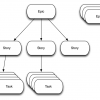 |
Seven Signs of Great Agile Leadership Agile teams are self-organizing, which means they do not need supervisors—at least in theory. But they do need leaders to create a shared vision of what the product will be. And having an agile team means that anyone can step up … including you. Lanette Creamer outlines seven qualities possessed by great agile leaders.
|
|
 |
Working with Nonfunctional Requirements Nonfunctional requirements describe aspects of the system that do not map onto a single piece of functionality. Essentially, they're constraints you need to operate within. Allan Kelly details how running performance tests regularly can be the key to nonfunctional requirements, as well as how much value these constraints produce.
|
|
 |
5 Ways Testers Can Mitigate Practical Risks in an Agile Team Testers who analyze quality in every aspect of the team’s deliverables also have a responsibility to mitigate risks and practical issues that are bound to come up, and help the team succeed in their product as well as at being agile. Here are five such issues that testers can help the team alleviate or avoid.
|
|
 |
How Agile Teams Should Use the Definition of Done The definition of done is an informal checklist that the team agrees applies to all pieces of work. But how does the definition compare to acceptance criteria? And should it apply to every task, or every story? How often should you review or change your definition? Allan Kelly helps you navigate your team's definition of done.
|
|
 |
Acceptance Criteria, Specifications, and Tests One of the benefits of agile is how it helps specify requirements. Instead of trying to predict the future with your requests, you can wait an iteration and see if more criteria are needed. This article gets into how executable specifications, specification by example, and test automation can help further improve your requirements management.
|
|
 |
Defining Acceptance Criteria for Agile Requirements Acceptance criteria can be helpful in expanding on user stories in order to capture requirements for agile projects. However, acceptance criteria should not be a route back to long, detailed documents, and they are not a substitute for a conversation. This article tells you how and when acceptance criteria should be written and employed.
|
|
 |
Product Owner, Product Manager, or Project Owner? If you really want to get the benefit of Scrum, you have to make the mind shift to product ownership, not project management or project ownership. The product owner role is often thought of as being a requirements specifier, when in fact a good product owner is a value maximizer, and a great product owner is a product maximizer.
|
|
 |
The Scrum Daily Standup Meeting: Your Questions Answered The daily standup, or daily scrum, is a short meeting the team uses to briefly communicate work commitments with each other. Dick Carlson answers some questions that agile teams, management, stakeholders, and those who are thinking about transitioning to agile commonly have about these daily standup meetings.
|
|
 |
Test Automation in the Agile World After decades of talking about test automation, the agile movement suddenly seems to be taking it seriously. You might be wondering what all the buzz is about. Sanjay Zalavadia talks about why test tooling is suddenly so critical, when teams should think of automating, and how to bring the change so that your team will embrace it.
|
|
 |
Stories, Epics, and Tasks: Organizing Agile Requirements Some teams only work with stories, but it can be difficult for a team new to agile to write stories that are easy to understand and provide value every time. An alternative is to add epics and tasks. Understanding the differences between each level and knowing what size story to use for each situation will improve the accuracy of your sprint planning.
|
|

